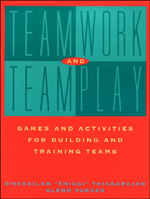 (Reprinted with permission from the CharityChannel's online book review forum, written by Michael Wyland.)
(Reprinted with permission from the CharityChannel's online book review forum, written by Michael Wyland.)
Being one of those relatively concrete-sequential, oldest-child, ISTJ (for the Myers-Briggs aficionados) people, I started my consulting career a little wary of all these “touchy-feely” group activities that trainers use when working with groups. Well, times change and (maybe) people do, too.
I have done a fair amount of group facilitation and training and have found all kinds of activities to be very beneficial in getting people to identify, focus on, and move toward shared goals. Many trainers discount or are ignorant of the requirements of adult learners—most adults won’t sit still (literally) for traditional, classroom-style instruction for more than forty-five minutes at a time.
This book by Sivasailam Thiagarajan and Glenn M. Parker—Teamwork and Teamplay: Games and Activities for Building and Training Teams—is an excellent, concise, easy-to-follow resource for anyone working in either team-building or team-training environments. As explained in the book’s introduction, team building “. . . increases the ability of an intact team to work together. . .,” while team training “. . . increases the knowledge and skills of the participants in various aspects of teamwork and being a team player. . . .” The book presents many exercises for each type of team experience.
Each of the thirty-eight activities is organized in an easy-to-follow format that includes:
-
purpose
-
team size (minimum/maximum recommended group)
-
required resources
-
time (to complete)
-
room setup
-
steps
-
debriefing
-
variations
-
templates, charts, overheads, as applicable.
The book also includes appendices that sort the activities by primary use (team building or team training), time and participants, and by topic area (desired outcome or issue being addressed). These appendices make it easy to determine at a glance which of the thirty-eight activities are most appropriate for a particular group or setting when designing training.
The value of the introduction bears emphasis. Many books have forgettable introductions; this book’s introduction is an excellent short essay on the value, uses, and benefits of building and training teams. Read it slowly—the authors make their points quickly. If you skim, you’ll miss something important.
Whether you’re a consultant or in-house trainer, regardless of organization size or mission, this book is a handy tool to improve the quality, participation, and outcomes from your group’s training.
Resources
Trustees who wonder how other nonprofit boards do their work may wish to visit www.CharityChannel.com, which reviewer Michael Wyland leads, and then click on the site’s “boards” forum. That chatroom is one of more than four dozen online forums for nonprofit organizations in the United States, Canada, and the United Kingdom. Topics include everything from accountability to “volunteers.”